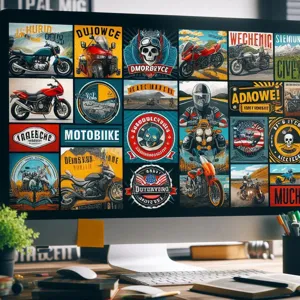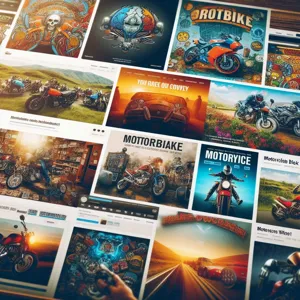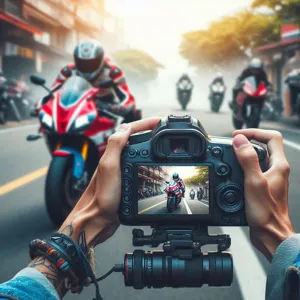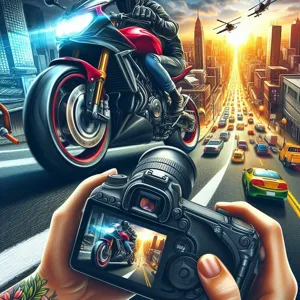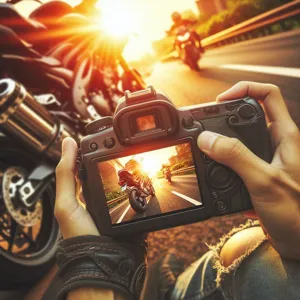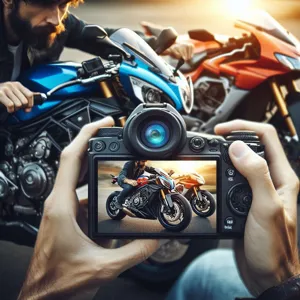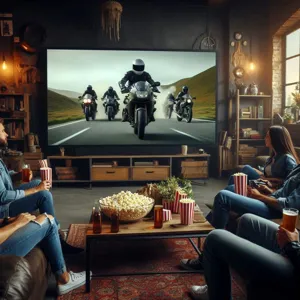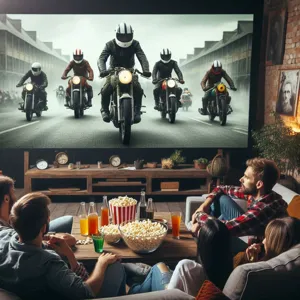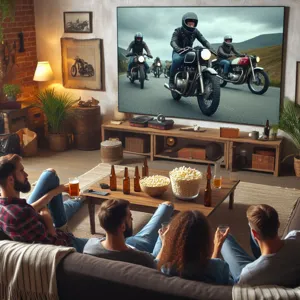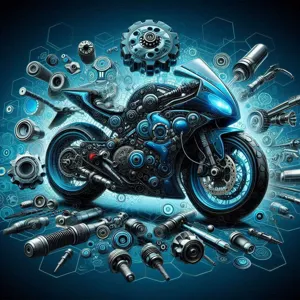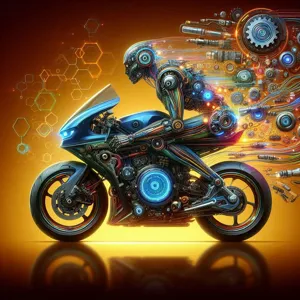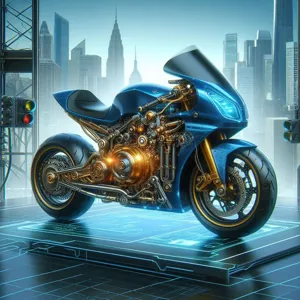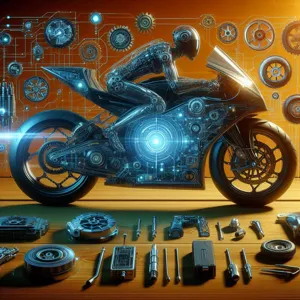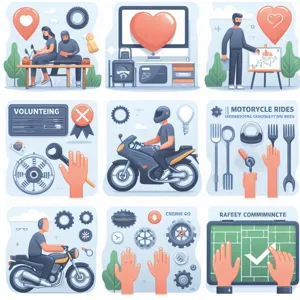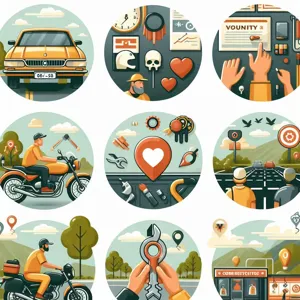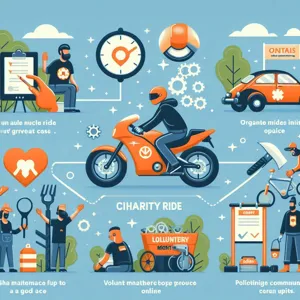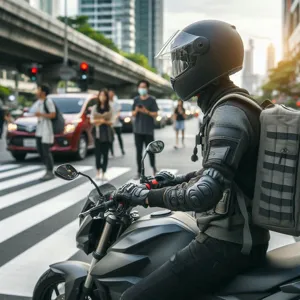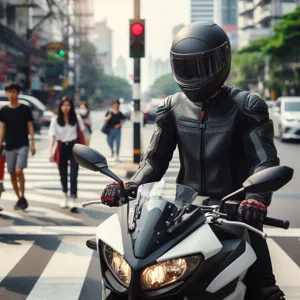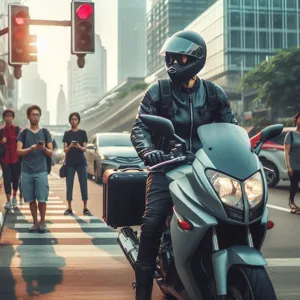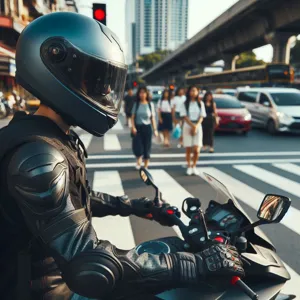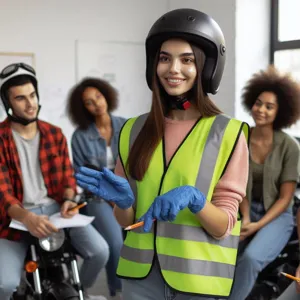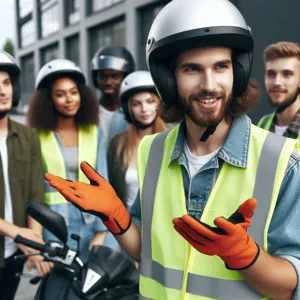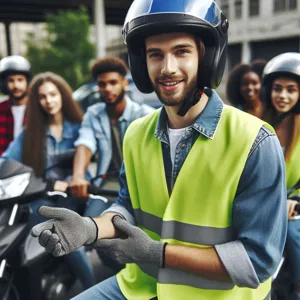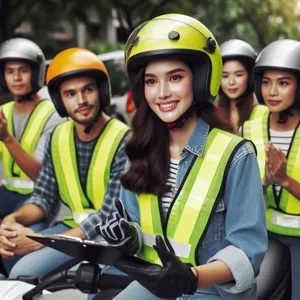Are you a motorcycle enthusiast with a wealth of knowledge and stories just waiting to be shared? If so, starting your own motorbike blog could be the perfect outlet for your passion! In today’s digital age, blogging offers an exciting platform to connect with fellow riders, share invaluable tips, and document your adventures on two wheels.
Whether you’re a seasoned biker or a newcomer eager to explore the open road, creating a blog allows you to express your love for motorbikes while building a vibrant community around your shared interests. In this comprehensive step-by-step guide, we’ll walk you through everything you need to know to launch your very own motorbike blog, from selecting the right platform and designing an eye-catching layout to crafting engaging content and promoting your posts. Get ready to rev up your passion and inspire others with your unique voice in the thrilling world of motorcycling!
1. Introduction: Why Start a Motorbike Blog?

Motorbiking isn’t just a mode of transportation; it’s a lifestyle, a culture, and for many, a deep-seated passion. As you navigate the open roads, feel the wind rush past, and experience the thrill of freedom that comes with every ride, you might find yourself wanting to share that exhilaration with others. This is where starting your own motorbike blog comes in.
Creating a motorbike blog offers a unique platform to express your love for riding, showcase your adventures, and connect with fellow enthusiasts. In an age where the digital landscape is saturated with content, a well-crafted blog can help you carve out your own niche in the vast world of motorcycling. Whether you want to review the latest bikes, share maintenance tips, document your travels, or simply reflect on the adrenaline rush of a weekend ride, your blog can become a valuable resource for both seasoned riders and newcomers alike.
Furthermore, starting a motorbike blog allows you to build a community. You can engage with readers through comments, social media shares, and collaborations with other bloggers and motorbike brands. This interaction can foster relationships with like-minded individuals who share your passion, turning a solitary hobby into a vibrant community experience.
In addition, blogging can serve as a creative outlet, allowing you to improve your writing skills, develop a unique voice, and explore various aspects of motorcycling that resonate with you. Whether you’re capturing the essence of a scenic route or detailing your journey through bike modifications, each post is an opportunity for personal expression.
So why wait? If the thought of sharing your motorbiking experiences excites you, then it’s time to rev up your passion and dive into the world of blogging. In the following sections, we’ll guide you step-by-step through the process of creating your motorbike blog, empowering you to share your adventures with the world.
2. Defining Your Niche: What Sets Your Blog Apart
Defining your niche is a crucial step in setting your motorbike blog on the path to success. The world of motorbiking is vast and varied, encompassing everything from touring and adventure riding to custom builds and vintage restorations. To carve out your own unique space, you need to identify what specifically excites you about motorbikes and where your expertise lies.
Think about your experiences and passions: Are you a seasoned rider who loves sharing thrilling tales of cross-country trips? Perhaps you have a keen eye for design and enjoy documenting the latest trends in motorcycle customization. Maybe you’re a tech enthusiast eager to delve into the mechanics of different bike models and the innovations shaping the industry. Whatever your angle, this is what will set your blog apart from the countless others in the field.
Consider conducting a bit of research to examine existing motorbike blogs. Analyze their content, audience engagement, and themes. Identify gaps in the market—topics or perspectives that are underrepresented. This will not only help you refine your focus but also position your blog as a go-to resource for readers seeking something fresh and different.
Once you define your niche, make it the cornerstone of your blog’s identity. Create a compelling tagline that encapsulates your unique viewpoint, and ensure your content consistently reflects this theme. By establishing a clear niche, you’ll attract a dedicated audience who shares your passion and values your insights, ultimately driving higher engagement and fostering a vibrant community around your blog. Remember, in the world of motorbiking, it’s not just about the bikes; it’s about the stories, the lifestyle, and the connections that fuel your journey.
3. Choosing the Right Blogging Platform

Choosing the right blogging platform is a pivotal step in your journey to creating a successful motorbike blog. With a plethora of options available, it’s essential to select one that aligns with your goals, technical expertise, and the audience you wish to reach. Each platform comes with its own set of features, flexibility, and user-friendliness, so let’s explore a few popular choices to help you make an informed decision.
**WordPress** is often regarded as the gold standard for bloggers. It offers unparalleled customization and scalability, allowing you to create a unique online presence that can grow with your blog. Whether you opt for WordPress.com, which is user-friendly and hosted for you, or the self-hosted WordPress.org, which gives you complete control and access to thousands of plugins and themes, this platform can accommodate your needs as you expand your content.
For those who prefer simplicity, **Blogger** is a solid choice. Owned by Google, it provides an easy-to-use interface, making it perfect for beginners. While it may lack some of the advanced features of WordPress, it’s a straightforward way to get your thoughts on motorbikes out into the world without the complexities of managing your own hosting.
If you’re looking to combine blogging with an engaging visual experience, consider **Wix** or **Squarespace**. These platforms are renowned for their stunning templates and drag-and-drop features, making it easy to create a visually appealing blog that showcases your passion for motorbikes. However, while they offer beautiful designs, you may find them a bit less flexible when it comes to scaling your blog in the future.
Lastly, don’t overlook **Medium**, especially if your focus is on writing and storytelling. This platform allows you to connect with a community of readers who appreciate quality content. However, it’s important to note that while Medium has a built-in audience, you have limited control over the design and branding of your blog.
Ultimately, the right blogging platform should resonate with your vision and be user-friendly enough to keep your creative juices flowing. Take the time to explore each option and consider factors such as ease of use, customization capabilities, and long-term growth potential. Once you find the perfect fit, you’ll be one step closer to sharing your love for motorbikes with the world!
4. Picking a Memorable Domain Name
Choosing the right domain name for your motorbike blog is a crucial step that can significantly impact your online identity and visibility. Your domain name is essentially your blog’s address on the internet, and it should reflect the essence of your content while being easy to remember and type. Think of it as the first impression you make on potential readers—make it count!
Start by brainstorming keywords that resonate with your passion for motorbikes. Consider terms related to biking culture, specific bike types, or even your unique perspective on the motorbike community. Combining these keywords can lead to creative and catchy names. For instance, names like “ThrottleDiaries” or “TwoWheelsAdventure” suggest a personal journey while clearly indicating the blog’s focus.
Simplicity is key; aim for a name that is short, sweet, and easy to spell. Avoid using complex words or phrases that could confuse your audience. Remember, you want to make it effortless for readers to find and return to your blog. Checking the availability of your chosen domain name is essential, so use domain registration sites to see if your idea is already taken. If your desired name is unavailable, don’t despair; try adding a prefix or suffix, or consider using a different domain extension like “.bike” or “.blog.”
Additionally, think about the future of your blog. Pick a name that allows room for growth and evolution. If you plan to expand your content beyond just reviews or tips, ensure your domain name won’t limit you to a specific niche. Lastly, once you’ve found the perfect name, secure it swiftly; good domain names can go fast!
In summary, a memorable domain name will not only enhance your blog’s visibility but also establish your brand identity in the motorbike community. Take your time with this step—after all, it’s the foundation on which you will build your passion-driven online presence.
5. Setting Up Your Blog: A Technical Overview

Setting up your blog is an exciting yet crucial step in your journey to share your passion for motorbikes with the world. While the creative aspects of blogging often take center stage, understanding the technical elements is just as important to ensure your content is accessible and engaging.
**Choose Your Blogging Platform**
First, you’ll need to select a blogging platform that aligns with your needs and technical expertise. Popular options include WordPress, Blogger, and Wix. WordPress, for instance, offers immense flexibility and a plethora of plugins, making it ideal for those looking to customize their blog extensively. If you prefer a more straightforward approach, platforms like Wix provide user-friendly drag-and-drop features that require minimal technical know-how.
**Domain Name and Hosting**
Next, consider your domain name—this is your blog’s online address and should reflect your motorbike theme while being memorable and easy to spell. Once you’ve chosen a name, you’ll need to secure a hosting service to store your blog’s files and make it accessible on the internet. Companies like Bluehost, SiteGround, and HostGator offer reliable hosting services tailored for bloggers, often with one-click WordPress installations to ease the setup process.
**Design Your Blog**
With your platform and hosting sorted, it’s time to focus on design. Choose a clean, responsive theme that enhances user experience—after all, your readers will be accessing your blog on various devices. Many themes are available for free, but investing in a premium theme can give your blog a polished, professional look. Ensure that your design showcases your love for motorbikes, with vibrant images and a layout that highlights your content effectively.
**Essential Plugins and Tools**
To maximize functionality, consider integrating essential plugins, especially if you’re using WordPress. Plugins like Yoast SEO can help optimize your content for search engines, while Jetpack can enhance your site’s security and performance. Social sharing plugins are also invaluable, allowing readers to easily share your posts, thus expanding your reach within the motorbike community.
**Content Organization**
Lastly, think about how you’ll organize your content. Categories and tags will help your readers navigate your blog seamlessly, making it easy for them to find articles on topics of interest, whether it’s bike maintenance tips, ride reviews, or the latest industry news. A well-structured blog not only enhances user experience but also helps with SEO, allowing your posts to be discovered more easily by search engines.
By carefully navigating these technical aspects, you’ll set a solid foundation for your motorbike blog, ensuring it’s not just a personal journal but a vibrant hub for fellow enthusiasts. With everything in place, you can shift your focus back to what you love most: sharing your passion for motorbikes with the world!
6. Designing Your Blog for Maximum Impact
Designing your blog for maximum impact is essential to capture the attention of motorbike enthusiasts and keep them engaged. The visual appeal of your blog is often the first impression visitors will have, and a well-designed site can convey professionalism, passion, and a love for all things motorcycle.
**Choose the Right Theme:** Start by selecting a clean, responsive theme that reflects the vibe of the motorcycling community. Opt for a layout that is easy to navigate, with clear categories and a logical structure. A visually striking header featuring a captivating image of a motorbike can set the tone for your blog right from the first glance.
**Color Palette and Typography:** Your color palette should resonate with the spirit of biking—think bold and dynamic shades like deep reds, blacks, or metallic hues that mirror the aesthetics of motorcycles. Pair these colors with easy-to-read fonts that maintain a balance between style and legibility. Remember, your readers will likely be browsing on various devices, so ensure that your design is mobile-friendly.
**Engaging Visuals:** Incorporate high-quality images and videos of motorbikes, rides, and events to create a rich, immersive experience. Visual content not only breaks up text but also engages readers on a deeper level. Consider adding galleries or sliders to showcase your favorite rides or modifications, allowing visitors to explore your content visually.
**Easy Navigation:** Organize your content into well-defined categories, such as reviews, tips, maintenance advice, and personal stories. A user-friendly menu will encourage readers to explore multiple sections of your blog, enhancing their experience and keeping them on your site longer.
**Interactive Elements:** Engage your audience by adding interactive features like polls, comment sections, or forums where readers can share their thoughts and experiences. This fosters a sense of community and encourages return visits, as readers feel more connected to your blog.
**Call-to-Action (CTA):** Don’t forget to include clear CTAs to guide your readers toward actions you want them to take. Whether it’s subscribing to your newsletter, following you on social media, or sharing your posts with fellow motorbike lovers, strategic CTAs can significantly increase interaction and engagement.
By thoughtfully designing your motorbike blog with these elements in mind, you’ll create a vibrant online hub that not only showcases your passion for motorbikes but also draws in fellow enthusiasts eager to join the conversation and share in the thrill of the ride.
7. Crafting Compelling Content: Topics to Explore

Creating compelling content is the heartbeat of your motorbike blog, and selecting the right topics to explore can set you apart in a crowded online space. Your audience is not just looking for information; they crave engaging narratives, expert insights, and authentic experiences that resonate with their passion for motorbikes. Here are some captivating topics to consider:
1. **Motorbike Reviews**: Dive deep into individual models, highlighting their features, performance, and your personal experiences. Compare different bikes within the same category to help potential buyers make informed decisions.
2. **Maintenance Tips and Tricks**: Share your knowledge on how to keep a motorbike in top shape. From oil changes to tire care, your readers will appreciate practical advice that they can apply to their own rides.
3. **Riding Gear Essentials**: Discuss the importance of safety and comfort by reviewing helmets, jackets, gloves, and other gear. Include tips on how to choose the right equipment based on riding style and conditions.
4. **Travel Diaries**: Document your adventures on the road, whether it’s a weekend ride or a cross-country journey. Share the sights, sounds, and challenges you face along the way, and inspire others to explore new destinations on two wheels.
5. **Interviews with Fellow Enthusiasts**: Feature stories from other motorbike lovers, including experienced riders, mechanics, and industry insiders. These interviews can provide diverse perspectives and foster a sense of community among your readers.
6. **Events and Competitions**: Keep your audience informed about upcoming motorbike events, races, and rallies. Sharing your experiences from these gatherings can also create excitement and encourage engagement within your blog.
7. **Custom Builds and Modifications**: Highlight the creativity and craftsmanship involved in customizing bikes. Showcase unique builds, discuss popular modifications, and even provide step-by-step guides for those looking to personalize their rides.
8. **Safety and Riding Techniques**: Educate your audience on safe riding practices and techniques. Address common challenges faced by riders, and offer solutions to enhance their skills and confidence on the road.
By exploring these topics, you can create a rich tapestry of content that not only informs but also entertains and inspires fellow motorbike enthusiasts. Remember, authenticity is key—share your genuine experiences and insights, and your passion for motorbikes will shine through, attracting a loyal readership eager for their next fix of two-wheeled excitement.
8. Capturing Stunning Visuals: Photography Tips for Motorbikes
When it comes to a motorbike blog, captivating visuals can make all the difference in drawing readers in and keeping them engaged. The right photograph isn’t just a picture; it’s a story waiting to be told. Here are some photography tips to help you showcase the beauty and thrill of motorbikes through your lens.
**Choose the Right Time and Location**
Lighting can drastically alter the mood of your photos. The golden hour—shortly after sunrise or before sunset—provides a soft, warm glow that enhances the details of your bike and surroundings. Look for picturesque locations that complement the essence of your motorbike, whether it’s a winding mountain road, an urban backdrop, or a serene countryside vista. These settings not only serve as stunning backdrops but also evoke a sense of adventure that resonates with fellow biking enthusiasts.
**Focus on Details**
Don’t just capture the bike as a whole; zoom in on the intricate details that reveal its character. Highlight the gleam of chrome, the texture of the leather seat, or the unique design of the engine. Close-up shots can evoke emotions and appreciation for the craftsmanship that goes into each bike. Remember, it’s the small details that often tell the biggest stories.
**Experiment with Angles**
Variety is key to creating a dynamic visual narrative. Experiment with different angles to showcase your motorbike from every perspective. Low-angle shots can give your bike a commanding presence, while high-angle shots can emphasize the surrounding landscape. Tilt your camera slightly to create a sense of motion, or shoot from behind the bike to capture the rider’s perspective. Don’t shy away from getting creative—sometimes the most unconventional angles yield the most striking results.
**Tell a Story**
Photography is an art of storytelling. Incorporate elements that convey the lifestyle and emotions of motorbiking. Capture a rider gearing up for a journey, the thrill of the ride with wind tousling their hair, or the camaraderie of friends gathered around their bikes. These candid moments can resonate deeply with your audience, fostering a connection that transcends mere visuals.
**Post-Processing Magic**
Once you’ve captured your stunning visuals, don’t forget the power of post-processing. Use software like Lightroom or Photoshop to enhance your images—adjust the brightness, contrast, and saturation to make your photos pop. However, aim to retain the authenticity of the image; over-editing can detract from the natural beauty of the bike and its surroundings. A little adjustment can go a long way in making your images shine.
By skillfully capturing the essence of motorbikes through these photography tips, you’ll not only elevate the aesthetic quality of your blog but also create a captivating experience that keeps readers coming back for more. Remember, each photo is an opportunity to share your passion and invite others into the exhilarating world of motorcycling.
9. Building an Engaged Community: Connecting with Readers
Building an engaged community is essential for any motorbike blog aspiring to foster lasting relationships with its readers. This isn’t just about accumulating followers or page views; it’s about creating a space where motorbike enthusiasts feel valued, heard, and connected to one another. Start by encouraging comments on your blog posts. Ask open-ended questions at the end of each article to invite readers to share their thoughts and experiences. This not only sparks conversation but also gives you valuable insights into what your audience cares about.
Next, leverage social media platforms to create a vibrant community. Join existing motorcycle groups and forums, or establish your own dedicated page where readers can interact with you and each other. Share not only your blog content but also behind-the-scenes glimpses of your biking adventures, tips, and even user-generated content. Hosting live Q&A sessions, weekly challenges, or photo contests can further engage your audience and make them feel like they’re part of a larger movement.
Don’t underestimate the power of email newsletters, either. A regular newsletter provides a direct line of communication with your readers, allowing you to share exclusive content, upcoming events, or special promotions. Encourage your readers to reply to these emails or participate in polls, fostering a two-way dialogue that strengthens their connection to your blog.
Finally, consider organizing meet-ups or group rides for your readers. There’s nothing quite like the camaraderie of fellow bikers sharing the road together. These events can create unforgettable memories and deepen the bonds within your community, turning casual readers into loyal fans. By prioritizing connection and interaction, you’ll cultivate a thriving community that not only supports your blog but also celebrates the passion for motorbiking.
10. Promoting Your Blog: Effective Marketing Strategies
Once you’ve crafted compelling content and established a unique voice for your motorbike blog, it’s time to shift gears and focus on promotion. Effective marketing strategies are essential for increasing your blog’s visibility and attracting a dedicated readership. Here are some tried-and-true methods to get your blog revving in the right direction.
First and foremost, harness the power of social media. Platforms like Instagram, Facebook, and Twitter are fantastic for sharing your posts and connecting with fellow motorbike enthusiasts. Create engaging visuals or short videos that showcase your rides, gear reviews, or maintenance tips, and share them alongside your blog links. Additionally, consider joining motorbike communities and forums where you can share your expertise and redirect interested members to your blog.
Next up, search engine optimization (SEO) is your best friend. Research keywords relevant to your niche—like “motorbike maintenance tips” or “best touring motorcycles”—and incorporate them naturally into your blog posts. This will help your content rank higher in search engine results, making it easier for potential readers to find you. Tools like Google Keyword Planner or SEMrush can be invaluable for identifying trending keywords within the motorbike community.
Collaborating with other bloggers or influencers in the motorbike niche can also amplify your reach. Guest posting on established blogs or inviting guest writers to contribute to yours can introduce your content to new audiences. Don’t forget to engage with your audience through comments and emails; building relationships with your readers can lead to word-of-mouth referrals, which are powerful for driving traffic to your site.
Lastly, consider investing in paid advertising, such as Google Ads or Facebook Ads, to target specific demographics interested in motorbikes. A well-crafted ad campaign can draw in new visitors and convert them into loyal readers.
By implementing these effective marketing strategies, you’ll not only promote your blog but also foster a vibrant community around your passion for motorbikes. So buckle up, get creative, and watch your blog gain momentum!
11. SEO Basics: Optimizing Your Blog for Search Engines
In the competitive world of motorbike blogging, understanding SEO basics is essential for driving traffic to your site and ensuring your passion resonates with a wider audience. Without proper optimization, even the most captivating content can get lost in the vast expanse of the internet. So, how do you make your blog stand out to search engines like Google?
Start by conducting thorough keyword research to identify the terms and phrases that potential readers are searching for. Tools like Google Keyword Planner, SEMrush, or Ubersuggest can help you uncover popular keywords related to motorbikes, such as “best beginner motorcycles,” “motorcycle maintenance tips,” or “motorbike reviews.” Once you have a list of targeted keywords, strategically incorporate them into your blog titles, headings, and throughout your content while ensuring that it reads naturally.
Next, pay attention to on-page SEO elements. This includes optimizing your meta descriptions, alt text for images, and using header tags (H1, H2, H3) to structure your posts effectively. A compelling meta description not only helps search engines understand your content but also encourages users to click through to your blog when it appears in search results.
Don’t overlook the importance of internal linking as well. By linking to other relevant posts within your blog, you not only keep readers engaged longer but also help search engines understand the relationship between your content. Additionally, focusing on creating high-quality, original content is paramount. Search engines prioritize fresh, valuable information, so regularly updating your blog with informative articles, reviews, and personal experiences will keep both your audience and search algorithms happy.
Lastly, ensure your blog is mobile-friendly and optimized for speed. A significant portion of users will access your site via mobile devices, so a responsive design is crucial. Tools like Google’s PageSpeed Insights can help you gauge your site’s performance and identify areas for improvement.
By mastering these SEO basics, you can enhance your blog’s visibility, attract a loyal readership, and share your passion for motorbikes with the world. Remember, the road to success is ongoing—stay informed about the latest SEO trends and continuously refine your strategy to keep your blog revved up and ready to roll!
12. Collaborating with Other Bikers and Bloggers
Collaborating with other bikers and bloggers can significantly enhance your motorbike blog, providing fresh perspectives, diverse content, and an expanded audience. The motorbike community is vast and passionate, filled with individuals who share your enthusiasm for two wheels and the open road. By fostering relationships with fellow riders and content creators, you not only enrich your blog but also build a solid network that can lead to exciting opportunities.
Start by reaching out to other bloggers who share similar interests or niches within the motorbike realm. Whether it’s adventure touring, custom builds, or motorcycle maintenance, collaborating on guest posts, interviews, or joint reviews can introduce your blog to new readers while allowing both parties to benefit from shared expertise. Consider organizing group rides or events where you can document experiences together, fostering camaraderie and creating engaging content that resonates with your audience.
Social media platforms are a great way to connect with other bikers. Participate in forums, Facebook groups, or Instagram challenges to engage with the community. Share each other’s content, participate in discussions, and support fellow bloggers by commenting and sharing their posts. This not only helps you stay relevant but also establishes your blog as an integral part of the community.
Additionally, consider hosting or participating in collaborative projects like charity rides, bike shows, or workshops. Not only do these events allow you to work alongside other bikers, but they also provide content opportunities and enhance your blog’s visibility. Document these experiences through articles, vlogs, or podcasts, capturing the spirit of collaboration and the stories that emerge from your shared adventures.
By collaborating with others in the motorbike community, you’ll not only keep your content fresh and engaging but also cultivate a sense of belonging within the biking world. This approach not only revs up your blog’s content but also fosters relationships that can lead to a loyal reader base, ensuring your passion for motorbikes shines through every post.
13. Monetizing Your Blog: Various Revenue Streams
Once you’ve established a solid foundation for your motorbike blog, it’s time to explore the exciting realm of monetization. Transforming your passion into profit can be incredibly rewarding, but it requires a well-thought-out strategy. Here are several revenue streams to consider, each with its unique benefits and approaches.
**1. Affiliate Marketing:** This is one of the most popular ways to earn money online. By joining affiliate programs, you can promote products and services related to the motorbike industry, from gear and accessories to maintenance tools and insurance. You earn a commission for every sale made through your referral links, allowing you to profit without the hassle of inventory management.
**2. Sponsored Content:** As your blog grows, brands may reach out to collaborate. Sponsored content involves creating posts that highlight a brand’s products or services in exchange for compensation. It’s essential to maintain authenticity; your audience trusts your opinions, so ensure that any sponsored content aligns with your blog’s ethos and interests.
**3. Ad Revenue:** Utilizing ad networks like Google AdSense can provide a steady income stream. By placing ads on your blog, you earn money each time a visitor clicks on them. While this method may not generate significant income initially, it can accumulate over time, especially as your traffic grows.
**4. Selling Your Own Products:** If you have a knack for creativity, consider developing your own line of products. Whether it’s branded merchandise, custom motorbike gear, or even e-books and courses on maintenance and riding techniques, selling your own products allows for higher profit margins and direct engagement with your audience.
**5. Memberships and Subscriptions:** Create a premium section of your blog where members can access exclusive content, tutorials, or community forums. Charging a subscription fee can provide a steady income while fostering a dedicated community around your passion for motorbikes.
**6. Events and Workshops:** If you enjoy connecting with your readers in person, consider hosting events or workshops. These can range from riding clinics to maintenance classes, and they not only provide a unique experience for your audience but also generate revenue through ticket sales.
By diversifying your revenue streams, you can maximize your blog’s earning potential while still sharing your love for motorbikes. Remember, the key is to stay authentic and provide value to your readers, ensuring that your passion project remains enjoyable and sustainable. As you rev up your monetization efforts, you’ll find that your motorbike blog can indeed become a thriving business venture!
14. Staying Motivated: Overcoming Writer’s Block
Writer’s block can be a daunting challenge for any blogger, especially when your passion for motorbikes fuels your desire to share stories, tips, and experiences with fellow enthusiasts. However, overcoming this barrier is not only possible but can also reignite your passion for writing. Here are several strategies to keep your creativity flowing and ensure your motorbike blog remains vibrant and engaging.
Firstly, set a routine that works for you. Whether it’s early mornings or late evenings, find a time when you feel most inspired and stick to it. Consistency breeds familiarity, and soon, your writing will become a natural extension of your daily life. If you find yourself staring at a blank page, consider changing your environment. Sometimes, a new setting—be it a cozy café, a park, or even the garage surrounded by your beloved bikes—can spark fresh ideas and perspectives.
Next, don’t hesitate to lean on your motorbike community. Engaging with fellow riders, attending motorcycle events, or joining online forums can provide a wealth of inspiration. Listen to their stories, ask questions, and explore topics that resonate with them. Collaborating on guest posts or interviews can also offer new angles that keep your content dynamic and relevant.
Another effective technique is to break down your writing into manageable chunks. Instead of aiming for a fully polished post, focus on jotting down ideas, outlines, or bullet points. This method eases the pressure of perfection and allows your thoughts to flow freely. You can always refine and enhance your ideas later.
Lastly, don’t underestimate the power of passion projects. Write about topics that excite you, even if they seem tangential to your main theme. Whether it’s reviewing the latest gear, sharing maintenance tips, or recounting a memorable ride, these subjects can rejuvenate your enthusiasm and help you rediscover why you started your blog in the first place.
By implementing these strategies, you can combat writer’s block effectively and keep the momentum of your motorbike blog alive. Remember, every rider experiences bumps on the road; it’s how you navigate them that defines your journey. Stay motivated, and let your passion for motorbikes drive your creativity forward!
15. Conclusion: Keeping the Passion Alive in Your Blogging Journey
As we reach the final stretch of our journey through the exhilarating world of motorbike blogging, it’s essential to remember that the heart of your blog is your passion for motorcycles. This passion fuels your creativity, drives your content, and keeps your audience engaged. Embracing this enthusiasm is what will set your blog apart in a vast digital landscape brimming with voices eager to share their own tales of the open road.
Creating a successful motorbike blog is not merely about assembling information or reviewing the latest gear; it’s about sharing your unique experiences, insights, and the thrill of the ride with a community that shares your love for two wheels. As you embark on this blogging adventure, keep your passion at the forefront. Write authentically, share your adventures, and don’t shy away from the challenges you face along the way.
Remember, your readers are looking for connection and inspiration. They want to hear about your latest journeys, your favorite routes, and those unforgettable moments that make riding a motorcycle so special. Engage with your audience, foster a sense of community, and encourage fellow bikers to share their stories.
Continuous learning is also key. Keep exploring new topics, stay updated on industry trends, and don’t hesitate to experiment with different formats—be it vlogs, podcasts, or live Q&As. This not only enriches your content but also keeps your passion alive as you discover new facets of the motorbike world.
In conclusion, as you take the handlebars of your blogging journey, let your passion be your guide. With dedication, creativity, and a genuine love for motorbikes, your blog will thrive, drawing in readers and fellow enthusiasts while celebrating the incredible journey that is motorcycling. Here’s to the open road ahead—ride safe and write well!
As we wrap up this step-by-step guide to creating your own motorbike blog, we hope you feel inspired and equipped to embark on this exciting journey. Your passion for motorbikes is a powerful fuel that can drive not only your blog but also connect you with a vibrant community of fellow enthusiasts. Remember, authenticity and consistency are key—share your unique insights, experiences, and adventures on two wheels, and your audience will surely follow. Whether you’re sharing tips, reviews, or personal stories, your voice matters in this exhilarating world of motorbikes. So rev up those engines, ignite your creativity, and let your passion roar through the pages of your blog! We can’t wait to see where the road takes you.


